A balanced, varied diet is important for all pets. Parrots are no different and the many myths out there about their diets are the cause of many health issues. So what do parrots eat?
Let’s have a look at parrot diet in the wild and what you should feed your domestic feathered friend to keep it happy and healthy.
This post contains affiliate links. If you make a purchase, a small percentage will go directly to Psittacology at no additional cost to you. Thank you for supporting Psittacology!
What do parrots eat in the wild?
In the wild, most parrots spend the majority of the day foraging. What exactly they eat of course depends on their natural habitat and the season, but their diets are usually heavy in seeds and fruits. Seeds contain plenty of fats whereas ripe fruit has a relatively high sugar content, which helps keep these active birds going.
In addition to seeds and fruits, wild parrots will really consume anything edible they come across. Their diets can be very varied. This includes things like flowers and flower buds, fresh shoots and, to the dismay of farmers, any tasty crops they can find. Some species also eat soil or visit salt licks to find the minerals they need.
Parrots are actually omnivores that do eat animal proteins when they get the chance. Any unlucky edible insects that find themselves in front of a parrot beak will definitely be gobbled up. In fact, some parrots even go for lizards or baby birds of other species if they get the chance!
Note: For domestic parrots, some boiled egg is a good alternative to these proteins. They don’t need much, though, unless they’re breeding.
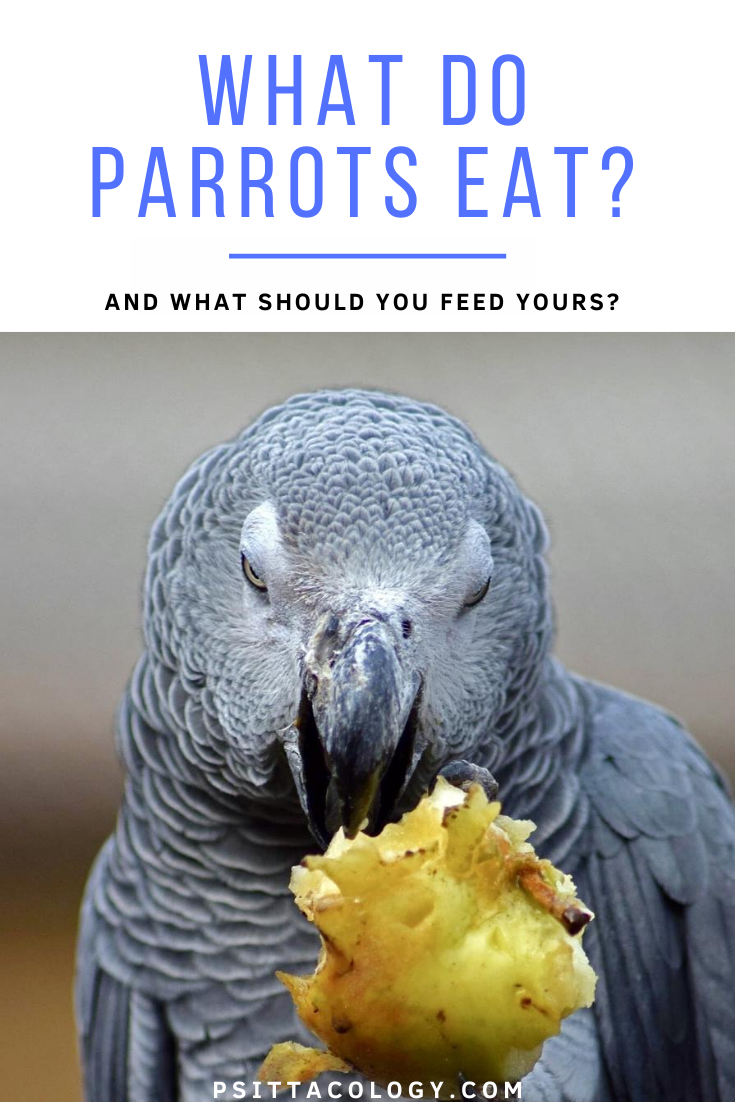
Wild parrot diet examples
To clarify wild parrot diet and its diversity a bit, here are a few summaries of scientific studies that looked at certain parrot species and what they eat.
Note that specific habitats were studied, so the same species in a different area might feed on entirely different foods.
- Lilac-crowned parrot (Amazona finschi): 82% seeds (many of which unripe), 10% fruit pulp, very few insects (Renton, 2001).
- Scaly-headed parrot (Pionus maximiliani): 70.4% seeds, 20.3% flowers, 7.7% corn, 1.6% fruit pulp. However, in the dry season, they ate more flowers and a lot of legumes, particularly fruits from the genus Inga (Galetti, 1993).
- Cape parrot (Poicephalus robustus): Specialized in eating kernels of fruits from the genus Podocarpus, usually unripe. They also eat other fruits and occasionally raid orchards. Generally speaking, the variation in their diet is relatively low (Wirminghaus, Downs, Symes & Perrin, 2002).
- Rosy-faced lovebird (Agapornis roseicollis): Ground feeders that prefer seeds (48%), leaves (29%), soil (9%) and even horse and cattle dung (5%)! (Ndithia & Perrin, 2006)
- Cockatiels (Nymphicus hollandicus): Flocks in a grain-growing district very strongly favored seeds. The ones in the study ate sorghum (60%), grasses (19.3%) and sunflower (9%). They preferred soft, young seeds to harder dried ones (Jones, 1987).
- Budgies (Melopsittacus undulatus): Almost exclusively seed eaters. They didn’t particularly prefer young seeds and fed on whatever was available (Wyndham, 1980).
Note: You’ll see a lot of scientific papers cited in this article. This is because parrot diet is still a pretty controversial subject surrounded by a lot of myths and hearsay. By approaching the topic in a more scientific way, hopefully we can shed some proper light on it!
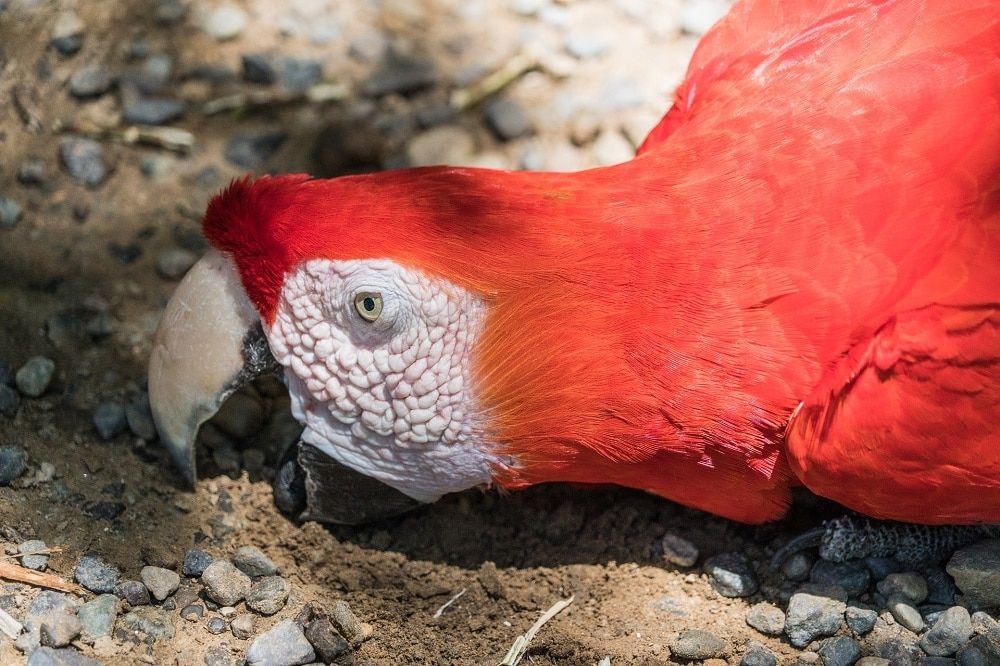
Notable exceptions
As the above should have illustrated, many parrots are primarily seed eaters (although not all of them feed on the same types of seeds, of course). There are some notable exceptions though: species that have a completely different diet.
One of them are lories and lorikeets from the tribe Loriini. These Australian parrots have evolved to feed mainly on sugary foods, particularly nectar and pollen from Eucalyptus tree flowers. Some species also eat a percentage of flowers, buds and fruits (Cannon & Emu, 1984).
It’s not uncommon to see lories and lorikeets in gardens in some areas in Australia. Some homeowners like to leave nectar and fruits out for them, which they happily accept. They can be quite bold!
Another unusual parrot is the Kea (Nestor notabilis), the world’s only alpine parrot. This species, which is naturally found in New Zealand, actually actively hunts chicks of other bird species. It will also eat carrion and even feed on live sheep, which is why it used to be hunted down by sheep farmers. You can watch a documentary about the fascinating Kea here.

What do parrots eat in captivity?
As with all pets, it’s extremely important to feed your parrot a suitable diet. All sorts of problems can occur if certain nutrients are lacking. Calcium especially is crucial, with birds developing brittle bones and other issues if they don’t get enough.
Obesity is also a common issue among pet parrots, because parrot diet in captivity is often just too high in calories and fats. So what should you be feeding your feathered friend? Let’s go into the different foods available for parrots and whether they make good choices or not.
Seeds
As we’ve just read in the section on what wild parrots eat, seeds are a popular choice for these birds in their natural habitat. This makes sense, as seeds are pretty dense in energy. They provide the calories needed to maintain parrot flocks while they fly around, sometimes pretty great distances each day.
The natural conclusion that we might come to based on this is that domestic parrots should be eating a seed-based diet too, right? Seeds have been the classic staple food for parrots for as long as anyone can remember.
More recently, however, it’s becoming more and more clear that seeds shouldn’t be the main component of your parrot’s diet. There are a few main reasons for this:
- Seeds lack essential nutrients, especially calcium (Werquin, De Cock & Ghysels, 2005) and vitamin A.
- Seeds are high in fat. Because our domestic parrots don’t get nearly as much exercise as wild parrots (even if they’re out of the cage all day or in an aviary), they simply don’t need this much fat in their diet. Obesity is a real issue.
- Many seed mixes contain large amounts of filler seeds that are even higher in fat than others. Oilseeds like sunflower and safflower seeds are a good example.
- The seeds that can be found in seed mixes don’t actually mimic wild parrot diet. A few species do naturally feed on grass seeds, but many go for completely different options.
- Commercial seed mixes are not available in the different stages of development that they would be in nature. If you scroll back, for example, you’ll see that cockatiels favor soft and young seeds rather than dried.
So does this mean that you shouldn’t give your parrot any seeds at all? Well, variety is the key to a healthy diet and seeds can definitely have their place. This especially applies to smaller parrot species that naturally almost exclusively eat seeds. Larger species should really not receive too much seed.
Some seeds, like sunflower seeds, make excellent training treats. Many parrots absolutely adore them, so much so that they can start favoring them over any other foods. Use them to motivate your bird during training!
Psittacology’s resident veterinarian, Dr. Daisy, says: Any vet will tell you that all-seed diets and even diets of 50% seeds + 50% pellets are certainly vitamin A deficient.
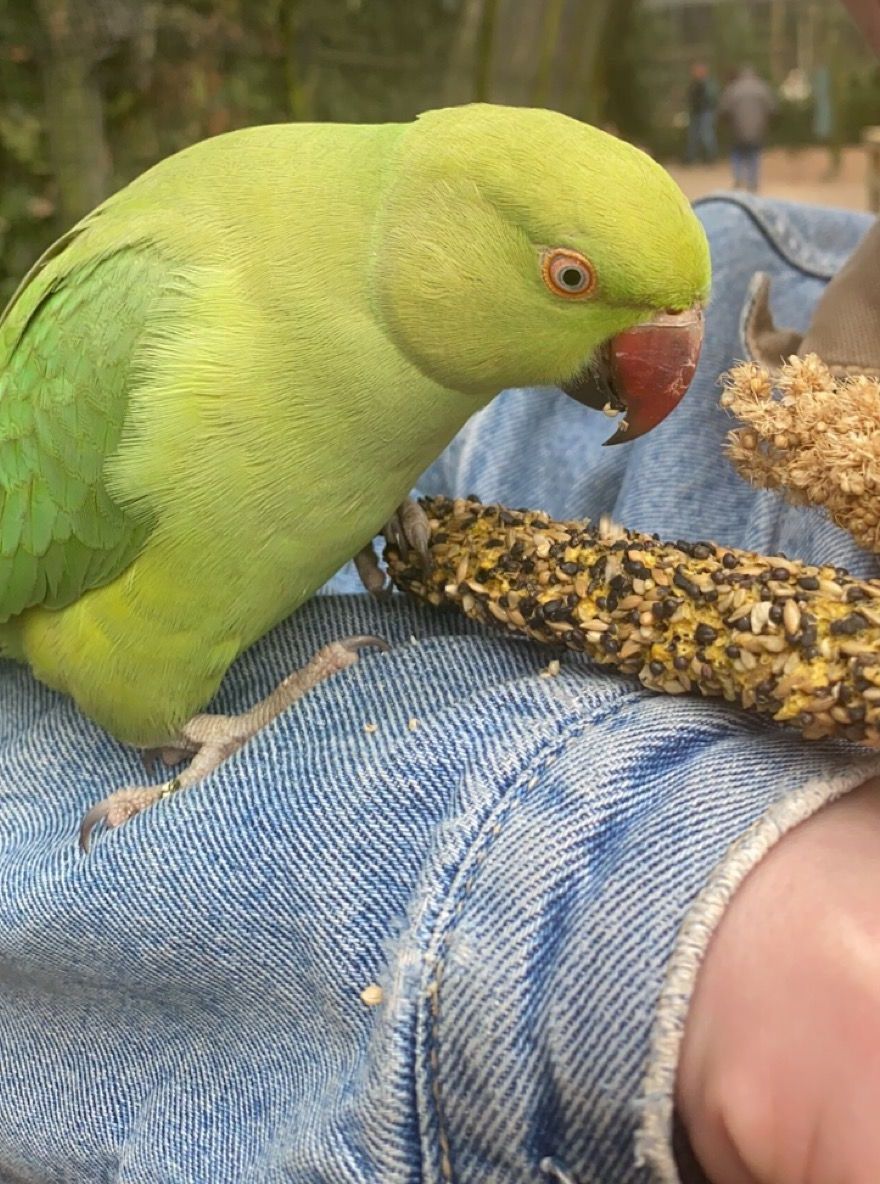
Pellet food
If you’re scratching your head now wondering what you should be feeding your parrot if seeds are on the no-no list as a staple, don’t worry. There are commercial pellet foods out there that are specially formulated to contain everything a parrot needs without the excess fat!
Whether you should be feeding parrot pellets or not has always been a point of discussion. Some parrot owners say that using an unnatural product like this as a staple food is just illogical.
It’s also been said that some pellet foods are not very high in quality at all. However, studies like a 1991 one by Ullrey, Allen & Baer do point to pellets being the superior choice, especially when combined with fresh veggies and fruits.
Psittacology’s resident veterinarian, Dr. Daisy, says: Pellet diets have come a long way since this study was performed in 1991! In fact, these days it’s generally agreed by avian veterinary experts that the majority of a domestic parrot’s diet should be composed of pellets, to maximise health and lifespan.
Although you can use parrot pellets as a staple, of course that doesn’t mean they should make up all of your bird’s diet. Fresh ingredients should not be skipped! We’ll go into those in a bit.
It is indeed true that some pellet diets are really quite low in quality, so it’s important to do your research and select a quality product. Cheaper foods may contain high percentages of low-nutrient filler ingredients like corn. They may even be laden with sugar. Sometimes the preparation process is also not ideal.
All this being said, pellets do seem to make an excellent base for parrot diet. Go for a high-quality brand (my choice is Harrison’s) and be sure to check the ingredient list. You want to see no sugar, no artificial colorants and few filler ingredients. Lots of whole ingredients are what you’re after.
Tip: Not all parrots will immediately accept pelleted foods. Just slowly start mixing in the pellets to start making the switch, all while keeping a close eye on your feathered friend’s weight. Don’t worry if it takes a while, your bird will get there!

Fresh vegetables
As mentioned in the previous paragraph, even high-quality pellets shouldn’t be the only thing your parrot is eating. Whilst most good pellet diets are complete and balanced (containing all the micro-nutrients your bird needs), feeding different foods helps combat boredom and encourage natural foraging behavior.
Although wild parrots rarely eat vegetables, they’re actually perfect for our domestic feathered friends. Veggies, especially the ones that are low in sugars, are low in calories but high in nutrients. They can be offered whole or chopped and there are loads of options, meaning lots of new foods for your parrot to try.
The vast majority of the vegetables that we humans eat are safe for parrots as well. So if you’re chopping some carrots, peppers, zucchini or whatever else, be sure to offer some pieces to your bird too. To find out more about which veggies you can feed, check out the article on vegetables for parrots.
Some things to remember:
- There are a few fresh options that are not safe. Garlic and onions are definitely out. Mushrooms are generally regarded with suspicion as well, as is tapioca/cassava.
- In some cases, veggies are safe but their leaves and stems are not. This applies to nightshades like tomatoes and eggplant as well as rhubarb, the leaves of which contain calcium oxalates in levels that can burn your parrot’s mouth.
- Some vegetables are quite high in sugars. Corn is an example and has actually been said to sometimes cause yeast infections in your parrot’s crop if you feed too much of it.
- Some vegetables are very watery and low in nutrients. Celery and iceberg lettuce are examples of this.
- Some vegetables and herbs can cause issues with calcium uptake when fed in large amounts. Examples are spinach and basil.
Did you know? Parrots don’t have receptors for capsaicin, the component that makes hot peppers so spicy. Your bird might go bonkers for (dried or fresh) chiles, jalapeños and even super-spicy peppers like habaneros and Madame Jeanettes. Just don’t give it a kiss afterwards…
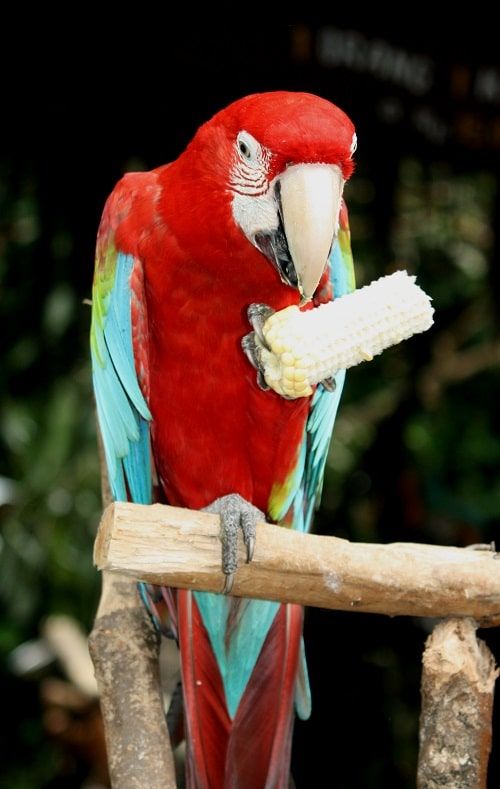
Fresh fruits
Many parrots will love fresh fruits. For added variety, fruits can absolutely be included in your bird’s diet. Just keep in mind what we mentioned in the section on wild parrot diet: parrots naturally tend to eat fruits way before they are ripe.
What this means is that they normally ingest fruits when they are still low in sugars and actually quite bitter. Fruit that was cultivated for human consumption, on the other hand, is usually sugar-laden to make it taste better. Nice for us, not ideal for your parrot, which might end up on the chunky side if you overdo it on fruit.
Small amounts of fruit a few times a week should be fine. Pretty much whatever you have on hand should happily be eaten! Check out the article on fruits for parrots if you want to know more.
Sprouts
As mentioned in the section on wild parrot diet, parrots naturally eat seeds in all their stages of development. Among that are sprouted seeds, which are much more nutritious than dried. The best part? You can easily sprout a whole range of seeds and legumes at home.
Sprouting is done by putting the seed on a wet paper towel, which you can then put on a light windowsill. Wait overnight and the nutrient content will already have shot up! You can also until small sprouts appear. Just make sure to keep the paper towel lightly moist. You can find more detailed instructions in the post on sprouting seeds for parrots.
Some super easy sprouting options are:
- High quality parrot seed mixes (with no added pellets) will sprout like a charm.
- You can get special sprouting mixes, which offer a variety of sproutable options.
- Sprout legumes like lentils (pictured below), mung beans, chickpeas or peas.
- Make sunflower and safflower seeds more nutritionally dense by sprouting them.
- If you have millet on hand, that works perfectly.
- Quinoa, chia seeds, brown rice, corn, flax, radish, mustard, sesame, spelt, wheat… seriously, this works with so many dried foods!
Tip: When sprouting, avoid beans for the reasons listed in the section on them above.
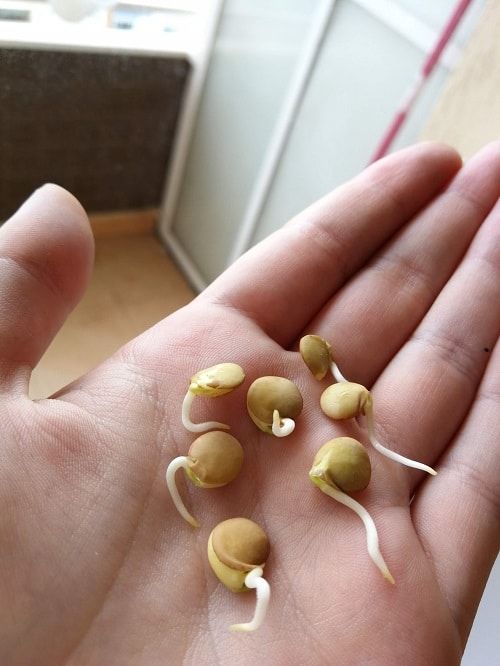
Grains
Many parrots naturally feed on all sorts of grains and you can totally include them in your feathered friend’s diet. Try cooking grains for a bit without salt to soften them.
You can feed the following (cooked): (whole wheat) pasta, quinoa, barley, oats, bulgur, amaranth, rice (brown and wild), buckwheat, amaranth and much more.
Foraged foods
If you have a garden or places nearby that are not polluted (like fields that are not by a road), you can actually go out foraging for your parrot. Many plants that we consider weeds, as well as branches and leaves from some trees, make excellent parrot snacks.
A few examples of treats you can find while out and about are:
- Leaves of certain weeds, like dandelion and clover.
- Parrot-safe flowers like daisies, roses, nasturtium, sunflowers and many more.
- Branches from trees like Eucalyptus (especially from parrots that hail from Australia), willow, birch and more. Parrots love nibbling on the leaves and destroying the bark.
Legumes
There are many legumes out there that your parrot can eat! Lentils, chickpeas, mung beans, green beans, peas, and even tofu (made from soy) can all be fed. Just soak dried legumes overnight to soften them.
Large beans (black, fava, kidney, lima and more) can be fed but they should be soaked and then boiled until they’re soft. When raw, they’re really hard for your parrot’s body to digest.

Homemade parrot food
Like to cook? There are lots of treats you can make for your parrots at home. Birdie bread, sweet potato balls, seed treats and much more can easily be whipped up. Most of these can be frozen, meaning you can use them for months to come.
You can find some fun recipes in the post on 5 homemade treats for parrots.
Did you know? Even calcium blocks can easily be made at home. Find out more in the calcium block DIY guide.
Treats
It’s important to train your parrot to understand basic commands like step up, come here, go away and more. Some parrot owners like to take it a step further and actually teach their bird all sorts of fun tricks!
Whatever you want to teach your parrot, the best way to do it is through positive reinforcement using treats. There are lots of options when it comes to training treats or if you just want to spoil your parrot a bit. Just keep in mind that none of these should make up a substantial part of the bird’s diet, as they can be high in fat or sugars.
A few things that most parrots will go crazy for are:
- Sunflower seeds
- (Pieces of) nuts like almond or walnut*.
- Commercial bird treats like NutriBerries or honey seed sticks
- (Pieces of) dried fruit like banana, papaya, coconut and more
- A piece of cracker with some peanut or almond butter
*Peanuts are a topic of discussion as they can be infected with a toxic mold. Human-grade, big-brand peanuts should be fine, but many bird owners choose to skip them.
If you have any more questions about what parrots eat or if you want to share your own experiences with parrot diet, don’t hesitate to leave a comment below!
Sources:
Cannon, C. E. (1984). The diet of lorikeets Trichoglossus spp. in the Queensland-New South Wales border region. Emu, 84(1), 16-22.
Galetti, M. (1993). Diet of the scaly-headed parrot (Pionus maximiliani) in a semideciduous forest in southeastern Brazil. Biotropica, 419-425.
Jones, D. (1987). Feeding ecology of the cockatiel, Nymphicus-Hollandicus, in a grain-growing area. Wildlife Research, 14(1), 105-115.
Koutsos, E. A., Matson, K. D., & Klasing, K. C. (2001). Nutrition of birds in the order Psittaciformes: a review. Journal of Avian Medicine and Surgery, 15(4), 257-275.
Ndithia, H., & Perrin, M. R. (2006). Diet and foraging behaviour of the Rosy-faced Lovebird Agapornis roseicollis in Namibia. Ostrich-Journal of African Ornithology, 77(1-2), 45-51.
Renton, K. (2001). Lilac-crowned Parrot diet and food resource availability: resource tracking by a parrot seed predator. The Condor, 103(1), 62-69.
Ullrey, D. E., Allen, M. E., & Baer, D. J. (1991). Formulated diets versus seed mixtures for psittacines. The Journal of nutrition, 121(suppl_11), S193-S205.
Werquin, G. J. D. L., De Cock, K. J. S., & Ghysels, P. G. C. (2005). Comparison of the nutrient analysis and caloric density of 30 commercial seed mixtures (in toto and dehulled) with 27 commercial diets for parrots. Journal of animal physiology and animal nutrition, 89(3‐6), 215-221.
Wirminghaus, J. O., Downs, C. T., Symes, C. T., & Perrin, M. R. (2002). Diet of the cape parrot, Poicephalus robustus, in afromontane forests in Kwazulu-Natal, South Africa. Ostrich-Journal of African Ornithology, 73(1-2), 20-25.
Wyndham, E. (1980). Environment and food of the budgerigar Melopsittacus undulatus. Australian Journal of Ecology, 5(1), 47-61.



Stunning information for the majority of bird owners